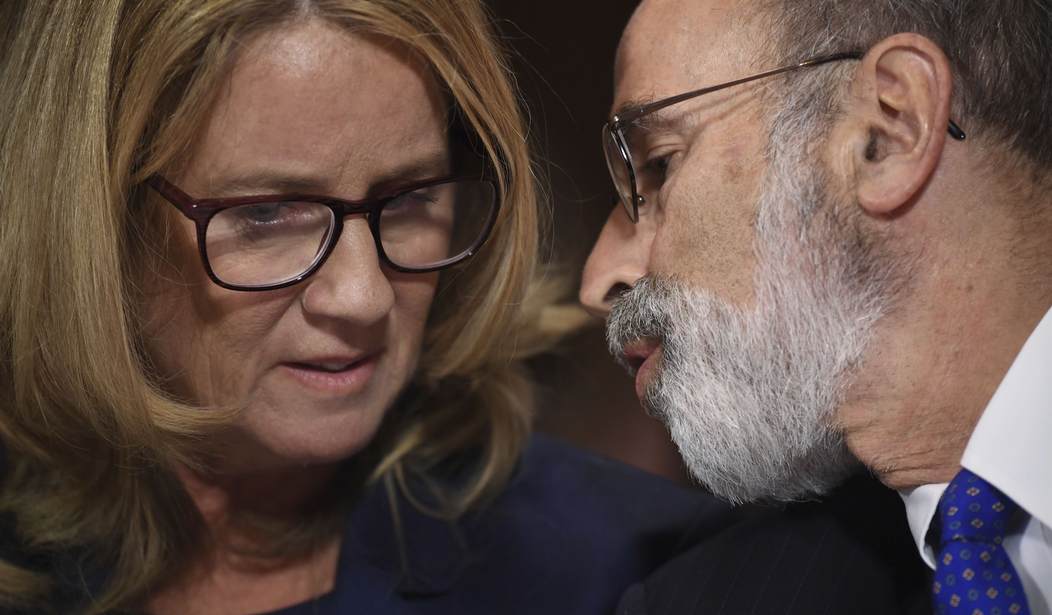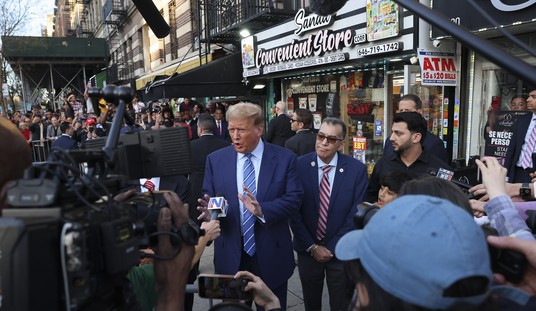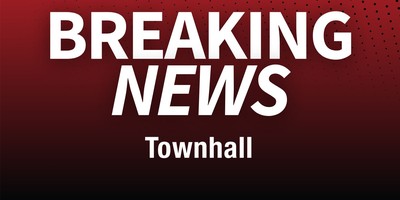As we continue to assess the only remotely credible (I'll follow up on this descriptor below) allegation against US Supreme Court nominee Brett Kavanaugh, I'd like to draw your attention to this interesting observation. It draws upon the initial Washington Post article that first publicly identified Dr. Ford and detailed her claim, as well as a largely-overlooked element of Ford's sworn testimony before the Senate Judiciary Committee last Thursday:
Even from the very cursory description of the therapist notes in the first WaPo story it is clear they are exculpatory, and that's why neither the Senate nor the FBI will ever see them.
— Phil Kerpen (@kerpen) September 30, 2018
Also why Ford said she didn't share them with WaPo, to preserve privilege. https://t.co/KmSG4WvXr9
The Post reported that Ford provided its reporters over the summer with portions of her therapy notes from 2012 (strangely, Ford says she can't remember whether or not she did so). In those notes, according to the Post, Ford described a rape attempt in her "late teens," perpetrated by four boys. Ford now says the "four boys" element was a mistake on the therapist's part (two boys attacked her, four were at the party), but that is an inconsistency nevertheless -- in addition to the other evolving inconsistencies about how many people were at the alleged gathering. Furthermore, 15, Ford's stated age at the time of the alleged incident, would not qualify as "late teens" under any definition. Her attorneys have declined to turn over these redacted records to the committee. Given the dearth of relevant evidence pertaining to this entire matter, wouldn't it be useful to confirm whether, in fact, Dr. Ford told her therapist six years ago that she'd been assaulted in her late teens, as the Post appeared to reveal? Then there's this exchange that occurred during veteran sex crimes prosecutor Rachel Mitchell's questioning of Dr. Ford:
Recommended
MITCHELL: In your July 6th text to The Washington Post that you looked at earlier, you said that this happened in the mid ’80s. In your letter to Senator Feinstein you said it occurred in the early ’80s.
FORD: Yes.
MITCHELL: In your polygraph statement you said it was high school summer in ’80s, and you actually had written in and this is one of the corrections I referred to 'early' and then you crossed that out. Later in your interview with The Washington Post, you were more specific. You believed it occurred in the summer of 1982 and you said at the end of your sophomore year.
FORD: Yes.
MITCHELL: You said the same thing I believe in your prepared statement. How were you able to narrow down the timeframe?
FORD: I can’t give the exact date.
These discrepancies were highlighted over the weekend by a longtime high-level law clerk, adjunct law professor and conservative writer. She tells me she spent roughly 25 years spotting such factual mismatches as part of her legal career. Let's review: The therapy notes, which have not been provided to the committee, were evidently seen by Washington Post reporters. Those journalists reported that the 2012 notes blamed four boys, and recorded that the event allegedly occurred when Ford was in her "late teens." Again, Ford now says she was in her early-to-mid teens, and implicates just two boys. And when Ford originally reached out to the Post in early July (prior to Kavanaugh's nomination, a detail that undermines suggestions that she's a partisan who cooked this up, in my opinion), she described the attempted assault as having taken place in the 'mid 1980s.'
She now estimates it took place in 1982, which falls within the realm of the early 1980's, the time frame she cited in her letter to Sen. Feinstein. (It may be worth noting that Ford would have been in her late teens in the mid-80s). But that's not all. When it came time to take her (dubious) polygraph in August, Ford personally hand-wrote the statement to which she attested. In that statement, she originally wrote that the attack had taken place in the "early 80's," then scratched out the word "early" before the test was administered. See for yourself by clicking on the yellow image in this tweet:
NEW: Dr. Ford's lawyers have just released her polygraph report. pic.twitter.com/YJFXNY3W8h
— Yashar Ali ?? (@yashar) September 26, 2018
This may all seem like preposterous nitpicking, but we have very little actual evidence to review in this case, hence the media's heavy emphasis on the emotional impact and optics from last week's performances before the judiciary committee. Ford's memory, her statements, and her therapy notes are really all we have, in terms of substance. So shifts (a) from the mid-80s to the early 80's, (b) from her late teens to early teens, and (c) from four perpetrators to two, cannot simply be ignored. I'm not saying any of this is "proof" that she's lying. I don't think she is. I'm underscoring the point that the human memory is a very tricky thing, especially several decades after the fact. Given the total lack of contemporaneous corroboration in this case, inconsistencies between the therapy notes and Ford's 'final' story (plus conflicts within various iterations of Ford's story) have to matter. At the very least, they help highlight why it would be profoundly unfair to defeat Kavanaugh's nomination over a single, unsubstantiated claim from 36 years ago, based on the information we currently have.
But what about the other allegations? Fair question. There are four others. One has been fully recanted, as we noted in an earlier post. A second was introduced 100 percent anonymously, with no names or contact information. Even so, the woman it appears to describe (who was dating Kavanaugh in 1998) has totally refuted it, on the record, as "offensive and absurd." A third was put forward by a woman who, by her own private admissions to former classmates (reported by the New York Times), isn't even sure Kavanaugh did it. She also offers zero firsthand corroboration, and journalists couldn't manage to confirm whether Kavanaugh was even present, after speaking with dozens of people -- including those she placed in the room. Finally, there's the insane gang rape cult claim. How's the corroboration process going on that accusation? Exactly as you might expect:
“WSJ has attempted to corroborate Ms. Swetnick’s account, contacting dozens of former classmates and colleagues, but could not reach anyone with knowledge of her allegations. No friends have come forward to publicly support her claims.” https://t.co/XF5l2n72Uc
— Shelby Holliday (@shelbyholliday) September 29, 2018
Her lawyer's embarrassing answers to painfully obvious questions have been damning, as has the fact that Kavanaugh's entire social circle says they have no idea who this person is. Who is she, and is she the least bit credible? Click this link and read away. I can't say for sure, but you may want to ask the ex-boyfriend who had to get a restraining order against her, or the parties in half-a-dozen lawsuits she's been a party to, covering complaints ranging from harassment to defamation. Or the former employer that says they caught her brazenly lying on her resume. In sum, there is one serious, potentially-credible allegation against Kavanaugh: Dr. Ford's. And to call it 'uncorroborated' at this point would be an understatement.
UPDATE - In a clinical and compelling analysis, Rachel Mitchell -- the career sex crimes prosecutor who conducted the questioning of Dr. Ford on Republican Senators' behalf last week -- lays out the specific reasons why all of the available evidence amounts to a case that's even weaker than a legally-unprovable 'he said/she said' situation (in either criminal or civil proceedings, the latter of which has a lower burden of proof). She addresses each of the three inconsistencies I mentioned above, in addition to reams of other facts. Here's one more discrepancy I hadn't previously thought about: "According to her letter to Senator Feinstein, Ford heard Judge Kavanaugh and Mark Judge talking to other partygoers downstairs while she was hiding in the bathroom after the alleged assault. But according to her testimony, she could not hear them talking to anyone."
Mitchell also notes that Ford claims to recall several very specific memories about the party (apart from the alleged attack), such as having exactly one beer, and not being on any medication at the time. But she could not recall how she got to or from the party. She testified that she ran from the house, looking over her shoulder to see if she was being chased. Then what? Her house was a roughly 20 minute drive away from the vicinity of the party, based on her recollection. This occurred in a pre-cell phone and pre-Uber era. Once she extricated herself from the threatening situation, how did she manage to get home? She has no memory of this whatsoever, and nobody has stepped forward as her driver. These are important points to consider, especially because -- again -- we have so little actual evidence, and zero contemporaneous corroboration.

























Join the conversation as a VIP Member